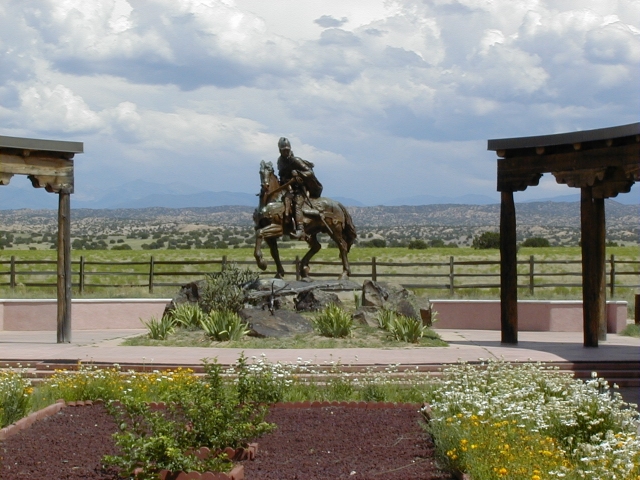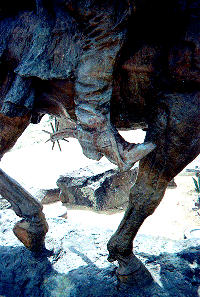 OÑATE'S MISSING FOOT
OÑATE'S MISSING FOOT
 OÑATE'S MISSING FOOT
OÑATE'S MISSING FOOT
By JAMES BROOKE
1998
This imposing twelve-foot high statue of Juan de Oñate
is located a few miles north of Española, New Mexico. In
January of 1998, it was damaged by vandals.
ESPAÑOLA, N.M. -- One moonless night
in early January, just as Hispanic New Mexicans were starting
to celebrate the 400th anniversary of the first Spanish settlement
in the American West, an American Indian commando group stealthily
approached a bronze statue here of the first conquistador, Don
Juan de Oñate. With an electric saw, the group slowly severed
his right foot -- boot, stirrup, star-shaped spur and all. "We took the liberty of removing Oñate's right foot
on behalf of our brothers and sisters of Acoma Pueblo," read
a statement sent by the group, which later sent to news outlets
a snapshot of its hostage foot. "We see no glory in celebrating
Oñate's fourth centennial, and we do not want our faces
rubbed in it."
The news quickly traveled from this lowland reservoir of Spanish
culture 120 miles to the southwest to a mesa, where cheers echoed
among the adobe brick houses of Acoma Pueblo. Since 1599, the
Acoma had passed from generation to generation the tale of how
Juan de Onate had punished the conquered Acoma by ordering his
men to chop off the right feet of 24 captive warriors.
"It was funny when it happened to the statue, but it wasn't
funny when it happened to the real people," said Darrell
Chino, an Acoma artisan.
At the Oñate Monument and Visitors Center, Estevan Arrellano,
the director, supervised the attachment of a new foot to the 12-foot-tall
statue in late January. He groaned: "Give me a break -- it
was 400 years ago. It's OK to hold a grudge, but for 400 years?"
"When I think of what Oñate did to the Acoma Pueblo,
I have a vision of Indian men lined up to have one foot cut off,"
Andres Lauriano, a Sandia tribal council member, wrote in The
Albuquerque Journal. "I see the blood pouring from their
legs as they crawled or hopped away. I see the bloody pile of
feet left behind."
But the foot-chopping incident should not overshadow Oñate's
positive achievements, argued Marc Simmons, author of "The
Last Conquistador: Juan de Oñate and the Settling of the
Far Southwest" (University of Oklahoma Press, 1991). The picture at left shows the repaired statue as it appears today. The welding line can not be seen in this picture, but
if a visitor looks closely the repair line is easily seen.
"In what is now the Western United States, he was the founder
of the livestock
industry, the mining industry, and he opened the first major road,
the Camino Real," Mr. Simmons said of the 16th-century entrepreneur
who was married to a granddaughter of Cortes. "He brought Christianity
and Western culture." 